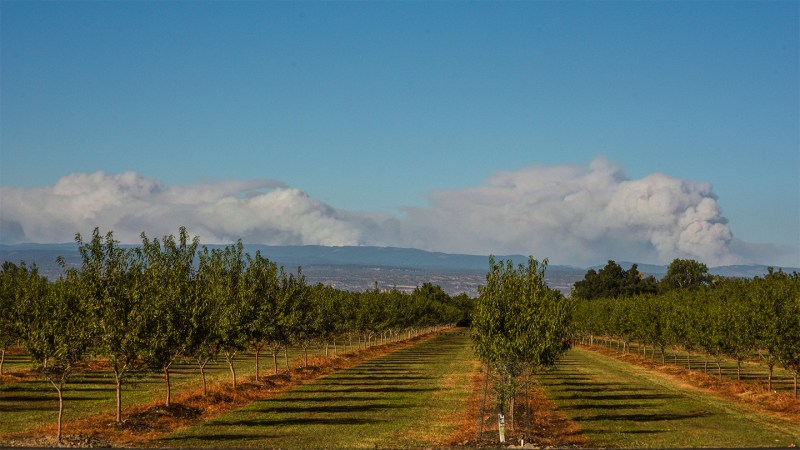Wildfires may put some of America’s favorite nuts — almonds, pistachios and walnuts — at risk.
The flames themselves aren’t to blame, but rather the long-lasting smoke from the megafires that have been scorching the western United States, a new study suggests.
When thick wildfire smoke blanketed California’s Central Valley in the late summer of 2020 and 2021, it blocked access to crucial sunlight. The disruption limited how much energy orchard trees stored over the winter, researchers report October 2 in Nature Plants. In the year following a megafire, some almond orchards saw up to a 60 percent decrease in nut harvests. This alerted scientists to an understudied effect of wildfire smoke in the state that produces 80 percent of the world’s almonds.
“Trees are just as susceptible to smoke as humans, and unfortunately, they can’t escape it,” says Jessica Orozco, a tree physiologist at the University of California, Davis. “They’re just stuck.”
Most trees make their food during warm, sunny weather, using sunlight to photosynthesize carbon and water into oxygen and carbohydrates. And just like someone who cans and pickles their summer harvest for the chilly months, leafless trees rely on stored carbohydrates during the winter and early spring to maintain and fuel growth.
In 2018, Orozco and her colleagues were curious how major environmental disruptions, like droughts or wildfires, would impact a tree’s carbohydrate storage. They collected twigs from more than 450 almond, pistachio and walnut orchards throughout California’s Central Valley to create a baseline. Orozco didn’t realize how quickly their work would come in handy.
“We were in California when the fires happened. The smoke was just so dense that we couldn’t go outside,” says Orozco, who remembers looking out her window in 2020 at dark red skies and parking lots covered in ash. She and her colleagues wondered how the trees were doing. “Then we were like, ‘Well, we have the perfect dataset to look at this!’”
Orozco and her team compared twig samples from years with over two weeks of prolonged megafire smoke (2020 and 2021) to samples from years without (2018, 2019 and 2022). After years with heavy smoke, they found that orchard trees stored fewer carbohydrates on average.
Smoke intensity also appeared to impact yield. Typically, one of the 56 almond orchards that Orozco and her team procured harvest data from might produce a few thousand kilograms of nuts per hectare each year. But during the years following wildfires, those numbers dropped.
On average, the orchards produced 30 percent fewer nuts in 2021 and 2022, and some almond harvests shrunk by up to 60 percent, the team found. For instance, one orchard that usually produced roughly 1,500 kilograms of almonds per hectare during a season harvested only 589 kilograms per hectare after a year with a megafire nearby.
Prior to this study, growers were primarily concerned about how wildfires affected crop quality, not yield, says Gabriele Ludwig, the director of environmental affairs for the Almond Board of California in Modesto. Smoke can taint vineyard grapes, resulting in undesirable flavors, and diminished sunlight keeps almonds from fully drying, which can result in mold.
“This paper raises a whole new aspect that has not been on growers’ radar screens — or anyone else’s radar screens for that matter,” she says. “Which is, what’s the impact on photosynthetic capacity?”
Because all trees create and store energy similarly, the researchers hypothesized that natural forest ecosystems could be hindered by megafire smoke, too. But Max Moritz, a wildfire dynamics expert at the University of California, Santa Barbara, stresses that a certain amount of fire is necessary in many forests. Small fires or prescribed burns can clear underbrush, making room for plants and animals, and some species, like lodgepole pines, need fiery heat to release their seeds (SNE: 5/9/23).
“Current fire regimes are very out of whack in many places, and thus smoke regimes probably are too,” says Moritz. “But my gut feeling would be that agricultural systems are at far greater risk for smoke exposure than natural ecosystems.”


